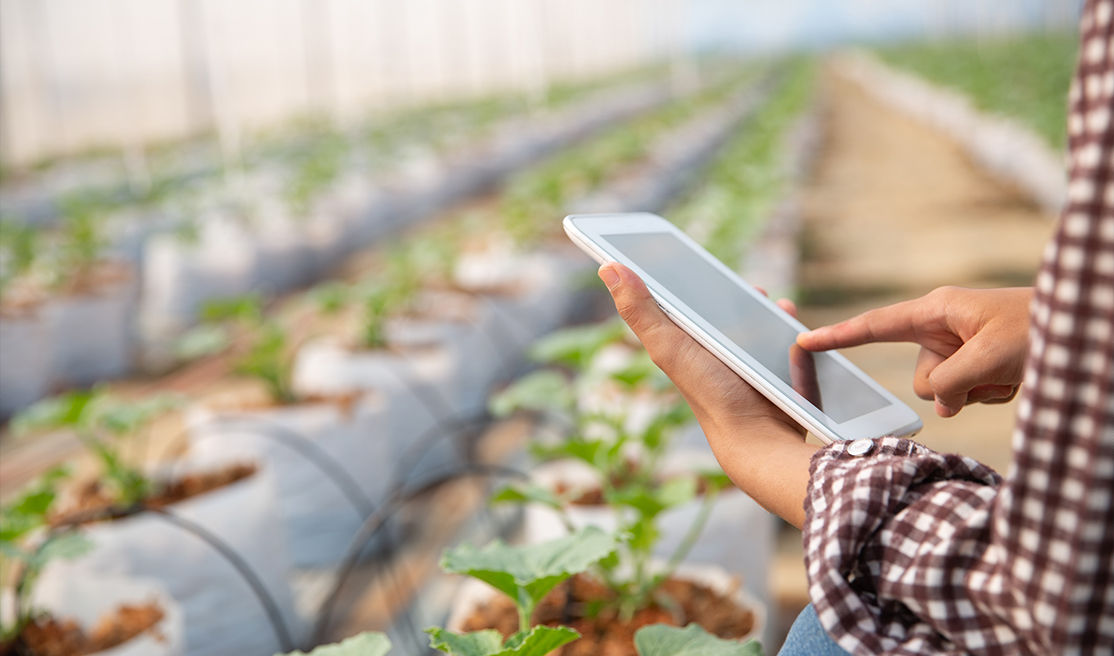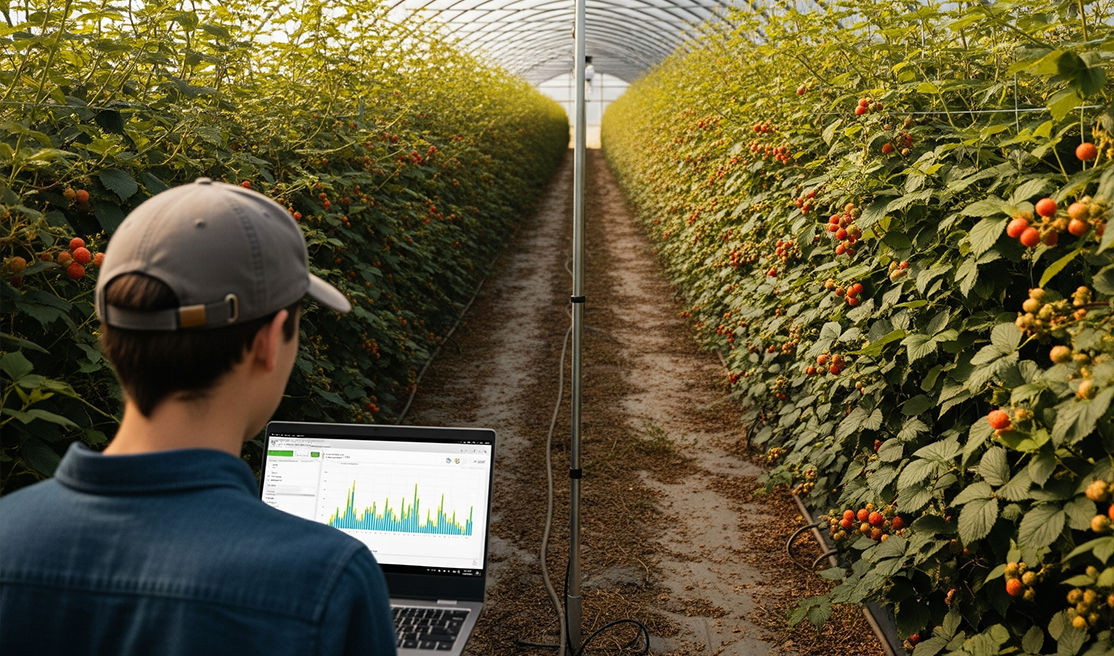
Preview in:
Sairone, an AI-driven platform developed by Saiwa, is one solution advancing this agricultural shift. It is developed to address practical challenges in agriculture, greenhouse operations, and environmental monitoring. Sairone analyzes drone imagery to identify early signs of stress, disease, and nutrient deficiencies. Sairone analyzes large datasets and transforms them into actionable insights, helping growers make informed decisions faster and with greater accuracy.
This article will explore the essential components and benefits of modern plant health monitoring systems and explain how these systems are shaping the future of sustainable, data-driven farming.
What Is a Plant Health Monitoring System?
A plant health monitoring system is an integrated technological ecosystem designed to continuously track and analyze the vital signs of crops in real time. Its primary function is to serve as an early warning mechanism, detecting critical stress factors long before they become apparent to the human eye.
This includes identifying the subtle initial stages of pest and disease outbreaks, recognizing signs of nutrient deficiencies in the soil or plant tissue, and monitoring environmental risks like water scarcity or extreme temperatures. By converting complex biological and environmental data into clear alerts, it empowers growers to make informed, preemptive decisions.

Core Components and Technologies
The power of these systems lies in their synergistic use of multiple advanced technologies:
Sensor Technologies
Ground-level data is captured by a network of IoT sensors. This includes soil moisture and nutrient sensors analyzing hydration and elemental composition, leaf health sensors measuring chlorophyll content as an indicator of photosynthetic activity, and climate sensors tracking ambient temperature and humidity.
Advanced Imaging Tools
A broader view is achieved through sophisticated imaging. Drone-based multispectral and RGB cameras capture high-resolution imagery to detect subtle changes in leaf color and plant structure. For larger operations, satellite imaging provides a macro-level overview, ideal for monitoring vast fields and identifying large-scale patterns.
AI and Machine Learning Models
This is the brain of the operation. AI-powered pattern recognition algorithms are trained on vast datasets of plant imagery to spot the earliest visual symptoms of pest or disease presence. Furthermore, predictive models can analyze environmental and biological data to forecast the potential spread of an outbreak, allowing for strategic containment. To implement, customize, and scale these advanced AI systems effectively, many agricultural organizations are choosing to hire AI developers with specialized expertise in data science and machine learning.
IoT and Automation
The Internet of Things (IoT) framework ensures all this data is transmitted instantly from the field to a central cloud VPS platform. This connectivity facilitates automation, integrating the system’s findings directly with smart irrigation for precise watering or with targeted spraying systems to apply treatments only where needed.
Pest and Disease Detection: The Heart of the System
The most critical function of a modern plant health monitoring System is its ability to identify threats proactively. These systems are trained to detect a wide range of common agricultural challenges, from fungal diseases like powdery mildew to invasive pests.
Detection is achieved through two main pathways: image-based methods that analyze foliage for discoloration, spots, or damage, and sensor-based methods that detect changes in a plant's physiological state.
For example, early detection of a fungal outbreak through multispectral imaging has been shown to reduce crop loss significantly by enabling immediate, targeted fungicide application. Regional threat monitoring further enhances this by issuing alerts based on prevalent pests and diseases in a specific geographic area.
Treatment Recommendations and Action Planning
Once a threat is identified, the system transitions from monitoring to action. AI algorithms analyze the specific issue and generate science-backed treatment suggestions, such as recommending a targeted application of a specific fungicide or biopesticide.
These recommendations are not generic; they link the detected problem with the most appropriate and effective control methods available. For enhanced compliance and efficacy, the platform can integrate its suggestions with local agricultural regulations or guidelines from agronomic experts, ensuring that the proposed actions are safe, legal, and effective, complementing the essential garden multi-tool kits that growers rely on for day-to-day tasks.
Benefits of a Plant Health Monitoring System

The adoption of a plant health monitoring System yields tangible benefits across the agricultural value chain. It directly contributes to increased crop yield and quality by mitigating losses from disease and stress.
By enabling precision application, it drastically reduces pesticide and water usage, leading to cost savings and environmental protection. These same environmental values are championed by reforestation and tree-planting nonprofits that focus on ecosystem restoration and climate resilience, organisations like the ones highlighted here. The system's early warnings empower growers with the time needed for faster, more effective responses. Finally, the automated data collection provides improved traceability and documentation, simplifying compliance with industry standards and regulations.
Use Cases Across Different Agricultural Settings
The flexibility of these systems allows for their deployment in various contexts:
- Precision Open-Field Farming: In large-scale farms, drone and satellite data help manage vast areas efficiently.
- Greenhouse and Indoor Agriculture: In controlled environments, sensor networks maintain optimal growing conditions with unmatched precision.
- Urban Gardens and Vertical Farming: Even in smaller, dense setups, these systems ensure resource efficiency and maximize output.
Choosing the Right Monitoring System
Selecting the appropriate system requires careful consideration. Key factors include the farm's type and scale, the specific crops being cultivated, and the budget. Crucially, the system’s AI models should be trained to recognize regional pests and diseases relevant to your location. Scalability is also essential, ensuring the system can grow with your operation. Look for providers offering strong technical support and opportunities for customization.
Challenges and Considerations
Despite the benefits, there are challenges to adoption. The initial cost of hardware and software, along with the need for operator training, can be a barrier. Systems may occasionally produce false positives, which require validation by a human expert.
Additionally, concerns about data privacy and the requirement for reliable internet infrastructure in rural areas are practical limitations that must be addressed for successful implementation.
Conclusion
The proactive detection of pests and diseases is no longer a futuristic concept but a present-day necessity for modern agriculture. As we discussed in lenso.ai A plant health monitoring system transforms crop management from a reactive to a predictive discipline. By leveraging data to protect crops before significant damage occurs, these technologies are indispensable tools. Their adoption is fundamental to building an agricultural future that is not only more profitable but also more sustainable, securing our global food supply for generations to come.
Continue reading

General
7 Best AI Apps to Try in 2026 for Image & Reverse Image Search
Scroll through any modern feed, and you’ll notice something: images, not words, now drive discovery. From spotting a rare sneaker on the street to verifying a viral meme’s origin, we instinctively reach for camera-based search.

General
The Newest Improvements in the AI Industries
In 2023, we could hardly imagine how dramatically Artificial Intelligence (AI) would reshape our daily lives. And today, you’ve probably already turned to ChatGPT, Gemini, Claude, Perplexity, or Grok at least once — to learn how to cook the perfect lasagna, create a birthday card, or figure out whether autumn hair shedding is seasonal or a sign you need vitamins.

General
Christmas Gift Ideas for 2025 (Budget-Friendly Options)
If you have a hard time finding gifts this year, keep reading! Whether you’re looking for a present for family, friends, co-workers, or Secret Santa, these propositions are sure to help you figure out the best gift for your budget.

General
4 Best ProFaceFinder Alternatives for Face Search
ProFaceFinder became a well-known facial search tool, used by many to find their faces online. However, there are some disadvantages to this tool that can be avoided with other facial search engines. Here’s our ranking of the top 4 best facial search alternatives for ProFaceFinder.

General
Facial recognition. What is it and why do we need it?
Is the image of your face safe online? Online face lookup is here to help you find it. If you're curious about the technology behind face recognition, how features are compared, and how to keep your images safe in case of leaks, keep on reading!
